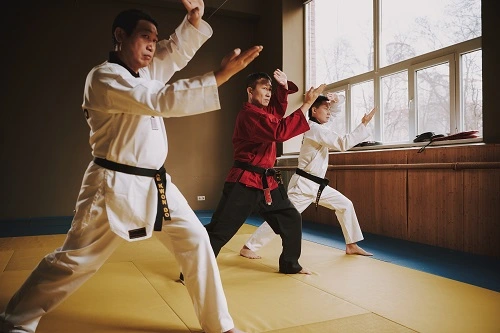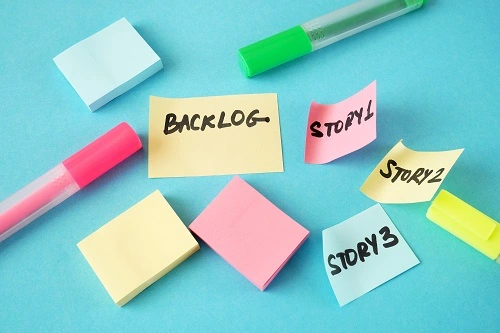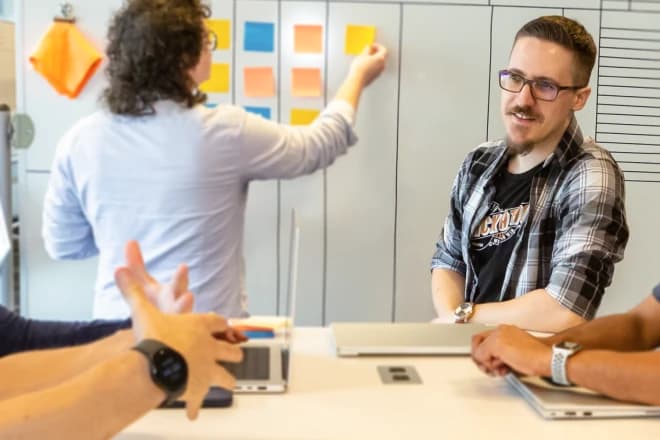The process
So far, we've laid a foundation for the series by introducing The Problem faced by large companies wanting to address the rapid pace of technological advancement. We've also explored qualities of The Dojo Coach, who gets up close and personal in the transfer of technical skills when developing product-focused teams at Discover.
Today we'll build on that foundation by discussing the relationship that unfolds from the moment that the requesting team comes up in the delivery queue. Some blueprinting and product definition stuff takes place to enable the team to be ready for their digital transformation and Dojo. As Dojo coaches, we do our best to live the values that we are imparting with teams. For this reason, the learning lifecycles of coaches themselves has a collective, significant, and ongoing influence on the process that we impart.
With these caveats out of the way, we'll be exploring three arcs that are related to the delivery process: team formation, executing the Dojo contract, and instituting continuous coaching.
So, let's get into it.
Team formation

When we discussed team transformation strategies in previous blogs, we explained why we decided to take the Dojo approach at Discover®. This often-used model in martial arts training isn't some pre-fabricated program; no traditional classroom setting whose trainer distributes flurries of handouts with made-up lab exercises that address stock team environments lays any meaningful foundation for transformation.
The Dojo embodies the immersive learning experience we seek with knowledge and experience being transferred capably from the coach-our version of the shifu-to team participants. The virtual venue of the Dojo begins to form at the place where the team's unique mission intersects with the coach chosen as the best match for their interests. In this evolution, information is sought, plans get formed, and enduring practices are instituted.
Therefore, the team and coach move into the Dojo setting preparing for an experience that will be highly customized and deeply personal, different from the journey that other team has taken.
A discovery and assessment of the team
The first act of an incoming coach is to conduct a discovery phase. Following an individualized intake process, the coach comes to the best understanding of where the team stands on its path to delivery.
Here are some of the topics we touch on:
-
Team formation. We want to know how well the team is formed-does it have a strong team culture and well-established team norms? Our efforts are geared to produce teams that are high-performing and self-empowered.
-
Product centricity. Does the team have a good understanding of the product and its roadmap? What kind of dependencies does this team have on other products?
-
Backlog. Remember that we aim to make this a tangible experience-to use real product team stories and features as examples to work though. These conversations shine a light on critical team processes of work intake and prioritization. Do team members function in an agile manner, and do they have stories for us to use as examples during the Dojo? If not step up, our Agile coach helps them generate a backlog.
-
Architecture. Having conversations about the architecture provides good insight on many levels. Does the team use modern tools and techniques? Does the tech anchor understand the technical landscape? Here's an insider tidbit: this topic also facilitates the matching of the team with the best coach from a technical point of view.
-
DevOps. From the coach's perspective, this is a key element in the assessment. A significant part of digital transformation occurs in our driving of extreme automation. We can't approach that with a team that does not have CI/CD pipelines or engage in automated testing such as TDD or BDD.
True, the questions in this assessment of the team's current state sound deceptively simple. But from the organic conversations that always unfold, we harvest an enormous amount of fruit. By comparing these results to the best practices of ourselves and our industry, we're able to meet the team where they are. The specific modules and improvements that we recommend become their learning journey through the Dojo.
Establishing transparency
Because the truest impact of the Dojo is to accomplish the change of team culture, we seek from the outset to establish a level of transparency that will stay permanently in place. The team, in reality, is a bunch of people who are sure to come into the Dojo bringing different sets of expectations. In order to standardize and reinforce Good Behaviors across the board, we find it essential to institute a plan in which communications-regular and open, and up and down the team hierarchy-are conducted.
Here is a quick list of our suggested communication channels. Note our purpose in having them and how often they're observed.
| Communication | Purpose | Frequency |
|---|---|---|
| Leadership Kick Off | Align with Business and BT leaders on dojo objectives, plan, and stakeholder management. | Once |
| Dojo Welcome Email | Confirm Dojo start date and set expectations with the product team. | Once |
| Product Team Kick Off | Establish psychological safety and set expectations for the Dojo. | Once |
| Dojo Lead Stand Up | Elevate impediments and ensure consistency in delivery. The coaching cohort can seek SME help, discuss Dojo delivery topics and issues. | Three times per week |
| Leadership Updates | Review Dojo progress and impediments that require director support or awareness. | Bi-weekly per area |
| Dojo Delivery Updates | Review with primary product team stakeholders the Dojo process and impediments. | Weekly |
| Dojo Discovery Readout | Report discovery findings, such as team-specific obs and recs and baseline metrics. | Once |
| Dojo Final Readout | Report on Dojo outcomes, metrics, and next steps for the team. | Once |
It is critical that communications not be taken lightly. Efforts to keep everyone on the same page and bring visibility to the mind shift of the team. Not only do important advancements and issues get telegraphed to leadership; this inclusion increases the opportunities of team members to engage, remove barriers, and reinforce their own transformation.
Although some of these conversations can be tough for teams that are accustomed to a strong hierarchy and top-down leadership, this communication helps us to achieve our desired outcome for building an independent, self-empowered team.
Executing the Dojo contract
During the discovery and assessment phase, the coach and team collected a lot of meaningful data. Based on that information, we outline a set of modules-some of which undergo modifications-to be used in addressing the specific needs of the team.

And this is where the magic happens. No, really.
Following the outline that has been agreed upon, the coach performs the workshops-typically four to five hours each week-that deliver the theory and content of the learning experience. In addition, to the workshops, we aim to spend several hours a day in hands-on activities time. Most of the latter occurs in the form of pair programming for a one-on-one focus; it's done sometimes as full-team "mobbing." Through this type of interaction, Dojo participants come to sharpen their skills and gain real-world experience using stories and features from their product backlog.
I'll say it again: The source of the material they use is their product backlog.
No significant skills development occurs through the use of a handful of made-up nice examples. Only through authenticity does a tangible experience emerge. Practicing on actual problems that require real solutions helps to reinforce the skills and behaviors that the team is learning.
Our learning modules are grounded in Craftworx-an internal framework of best practices and tools that are built by Discover for Discover. By evolving our approach continuously to follow inner/open-source principles, we enable engineers to use the best technology to build world-class products.
Instituting continuous coaching
Up to now, we've done all this great learning as part of the Dojo. So, what gives with continuous coaching?
Simply put, it's about muscle memory-the act of committing a specific motor task to memory through repetition. Any movement that you make or new skill that you adopt requires brain activity. This holds true even if the skill is a complicated or complex one. After repeating it enough times, you trigger the recognizable pattern for it that has been stored in your brain.

Now, the scary part.
There are some, like author Malcolm Gladwell, who suggest that it takes 10,000 hours to master a new skill. On the other hand, others such as writer Josh Kaufman suggest that it might take as little as 20 hours to become proficient-somewhat better news. I'm guessing the answer is somewhere in between, based on your personal talents and the type of teaching you've received. The point here is that the new skills acquired by our engineers need to be practiced and reinforced. And that's what brings continuous coaching into play.
Our goal is to sustain and reinforce the new behaviors that we've introduced. We accomplish this through regular check-ins that provide continuing nurture for the team. The ongoing contact also provides the team with a go-to person for any lingering questions on topics; they might have practiced something in Week One, for example, and could use a bit of a refresher.
Keep the end in mind
It's important to note that, just like the product teams that have joined us in a Dojo, coaches are also on a journey. As a result of living agilely, we know that our material isn't perfect, nor do we have the perfect delivery process. We, ourselves, look constantly to improve.
Our final blog, The Dojo Outcome, will wrap this series by touching on what we've seen as outcomes in a team's learning journey.



